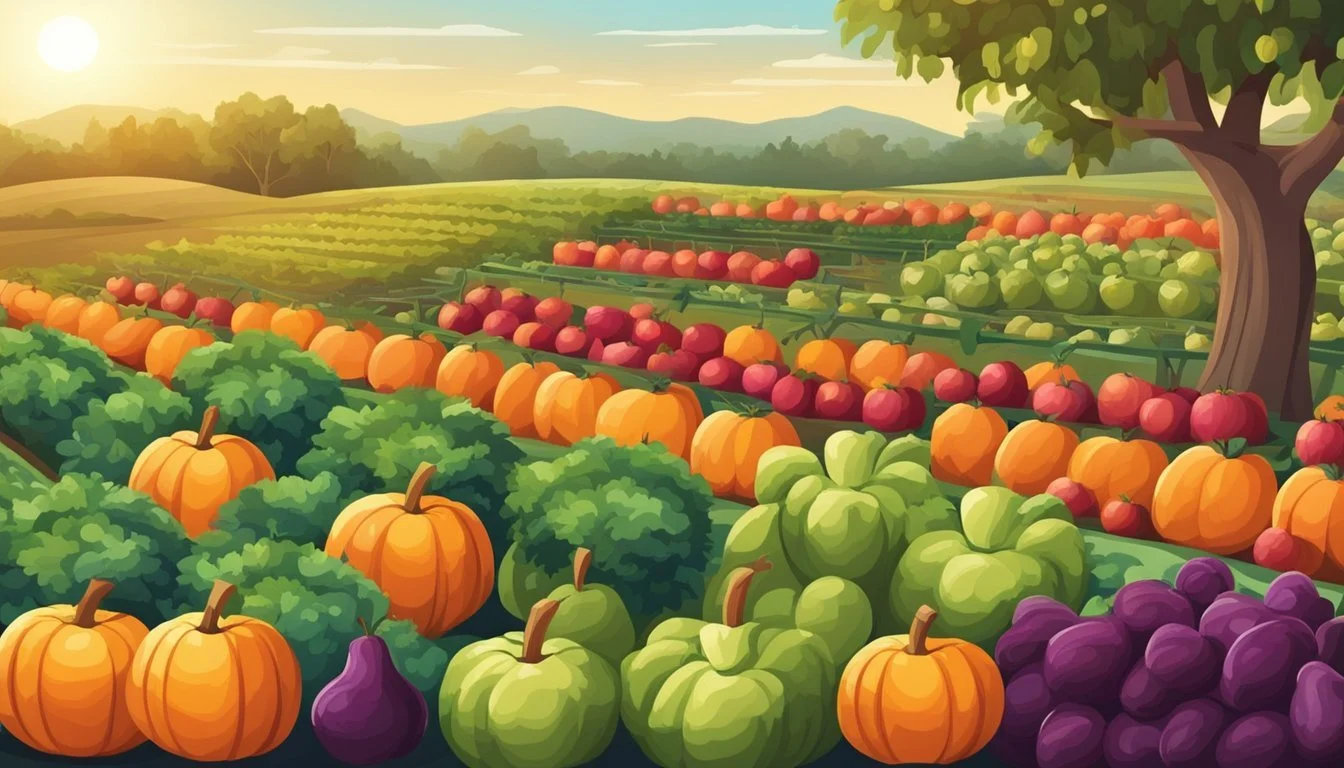Georgia Seasonal Fruit & Veg Guide
Your Ultimate Fresh Produce Calendar
Georgia's rich soil and favorable climate conditions offer a bounty of seasonal fruits and vegetables throughout the year, heralding a tradition of farm-to-table practices long cherished in the state. From the sweet peaches that have made Georgia famous to the juicy tomatoes and crisp greens that fill the local farmers' markets, there's an abundance of fresh produce to be enjoyed. Seasonal eating not only supports local agriculture but also ensures that consumers are getting the most flavorful and nutrient-dense produce available.
The concept of farm to table is deeply rooted in Georgian cuisine, where the distance between the harvest and the dinner plate is often remarkably short. This guide serves as a compass for navigating through the state's seasonal offerings, providing a roadmap for selecting fruits and vegetables at the peak of their freshness. As each season unfolds, so do the flavors inherent in the local produce, matched perfectly with the time of year.
Farmers and food enthusiasts alike take pleasure in the rotating calendar of Georgia's produce, which is synonymous with variety and quality. Whether one is a seasoned cook or a beginner in the kitchen, understanding the ebb and flow of seasonal availability is key to enjoying what Georgia has to offer in terms of fresh, local fruits and vegetables. This seasonal guide is tailored to help make the most of the state's generous and diverse crops, ensuring every meal is as fresh as it is delicious.
What’s in Season in Georgia Right Now?
Understanding Georgia's Climate and Seasons
Georgia's diverse climate significantly impacts its agricultural calendar, offering a broad spectrum of growing conditions throughout the state. The region's weather patterns and temperatures vary, influencing when and where different fruits and vegetables can be cultivated and harvested.
Weather Patterns and Growing Conditions
Georgia experiences a humid subtropical climate characterized by hot summers and mild winters, punctuated by occasional cold spells. This climate supports a wide range of fruits and vegetables. Growing seasons are generally longer in the southern areas due to the warmer conditions. The state receives ample rainfall, crucial for agriculture, though it can vary from year to year.
Spring: Mild temperatures, risk of late frosts
Summer: Hot, humid, conducive to heat-loving crops
Fall: Cooler temperatures, less humidity, suitable for cool-season crops
Winter: Mild, variable conditions with a chance of below-freezing temperatures
Regional Variations and Warmest Areas
Georgia's topography divides it into distinct regions, each with its own microclimates and growing conditions.
Region Description Northern Mountains Colder temperatures, shorter growing seasons Piedmont Moderate conditions, diverse agriculture Coastal Plains Warmer temperatures, longer growing seasons
The warmest areas, typically conducive to a lengthier growing period, include the southern regions and coastal areas like Savannah and Valdosta, which fall into the USDA hardiness zones 8a and 8b. These zones support not only staple crops but also fruit trees like citrus, benefiting from these milder winter temperatures.
Spring Harvest
In Georgia, spring offers a refreshing variety of produce as the state transitions from cool winter crops to an array of vibrant spring selections. Consumers and chefs alike eagerly anticipate the fresh flavors that this season brings to the table.
Early Spring Selections
Early spring in Georgia is marked by the arrival of tender greens and herbs, setting the stage for refreshing dishes after the winter months. The mild climate allows lettuce varieties such as Butterhead and Loose Leaf to thrive, offering crisp textures and flavors. Strawberries also begin to make their first appearances, sweet and ripe, much to the delight of fruit lovers.
Mid-Spring Abundance
As temperatures rise, mid-spring ushers in a greater variety of crops. Strawberries continue to flourish, while the fields are dotted with the emergence of carrots and the distinct spears of asparagus. These staples become central to seasonal cuisine, offering a blend of sweetness and earthiness.
Strawberries: Sweet and abundant
Carrots: Various types coming into season
Asparagus: Fresh and tender stalks
Late Spring Harvesting
Late spring sees the continued growth of earlier crops and the addition of more heat-loving varieties. Strawberries remain in the spotlight, reaching peak sweetness. Both the greens and the herbs are fully established by now, offering a diverse palette for both raw and cooked presentations. The season's bounty is rich and at full display in local markets and menus.
Strawberries: At peak sweetness, perfect for jams or fresh consumption
Greens & Herbs: Mature and flavorful, ideal for salads and garnishes
Lettuce: Continues to be a cool, crunchy staple
Summer Bounty
Georgia's summer months bring a remarkable variety of fresh fruits and vegetables. Farmers' markets become showcases of the state's agricultural wealth, with many crops reaching their peak during this warm season.
Early Summer Crops
In early summer, Georgians begin to enjoy the first flush of peaches, a state icon, offering juicy, sweet flavors. Blueberries (how long do blueberries last?) also make an early appearance, bursting with antioxidants and versatile for both fresh eating and culinary uses. Tomatoes start to ripen, presenting a range of varieties from heirloom to cherry, each with a distinct taste perfect for salads or sauces.
Peaches: Juicy and sweet, dominating the early summer markets
Blueberries: Available for fresh consumption and culinary uses
Tomatoes: Heirloom and cherry varieties begin to ripen
Peak Summer Varieties
At the height of summer, the selection expands dramatically. Watermelons and cantaloupes (how long does cantaloupe last?) provide refreshing hydration and are a staple at summer picnics and barbecues. The variety of tomatoes flourishes, becoming a centerpiece for many dishes with their full, rich flavors. Corn stands tall in the fields, with its sweet kernels eagerly anticipated for grilling and boiling.
Watermelons: Refreshing and hydrating, perfect for hot summer days
Cantaloupes: Sweet and rich in flavor, a picnic staple
Corn: Sweet kernels, ideal for grilling and boiling
Tomatoes: Peak of flavor diversity, enriching a myriad of dishes
Late Summer Harvest
As summer progresses, peppers of all kinds hit their stride. The spectrum of peppers from sweet bell to fiery hot varieties, offers something for every palate and dish. This is also the time when late-season peach varieties reach maturity, with a sweetness that captures the essence of a Georgia summer. Harvests continue for blueberries and tomatoes, ensuring that the table stays abundant with vibrant, fresh produce until fall takes over.
Peppers: A range from sweet bell peppers to hot varieties for diverse culinary uses
Peaches: Late-season varieties offer lasting sweetness
Blueberries and Tomatoes: Continue to feature prominently in late summer harvests
Autumn's Harvest
As the days shorten and the temperatures cool, Georgia's farms transition from the summer's bounty to the robust and varied harvest of autumn. The changing leaves set the stage for a diverse array of produce ready to be picked throughout the season.
Early Fall Crops
In early fall, Georgian farmers begin harvesting a variety of fruits and vegetables. Apples come into full swing, with numerous varieties available for picking. Georgia's apple orchards offer a flavorful selection often starting from late August through November. Consumers can enjoy crisp, juicy apples straight from the local orchards. Similarly, pears also make their way to the farm stands, with their buttery and sweet flavors.
Apples: Late August - November
Pears: September - October
Mid-Fall Harvest
As autumn progresses, the heart of the season brings a celebration of Pumpkins and Sweet Potatoes. These staple fall crops are essential for their versatility in both sweet and savory dishes. Pumpkins, not just for decoration, are harvested for their flesh that is used in pies, soups, and bread. Sweet Potatoes, another Georgia favorite, possess a rich, earthy flavor that intensifies with cooking, making them perfect for a multitude of recipes from baked goods to casseroles.
Pumpkins: October
Sweet Potatoes: October - November
Late Fall Offerings
Late fall provides the perfect growing conditions for a range of Greens including kale, collards, and turnips, all thriving in cooler weather. Peanuts, another Georgia staple, are also gathered in late fall. Often associated with the state, peanuts are a versatile crop used in a variety of products, from peanut butter (how long does peanut butter last?) to snacks. As the season winds down, these crops can often withstand the first frosts, making them available right up to the start of winter.
Greens: October - December
Peanuts: September - October
Georgia's agricultural landscape offers a rich tapestry of seasonal produce that reflects the state's diverse climate and farming practices. Autumn's harvest showcases the deep connection between the land and the table.
Winter Crops
In Georgia, the winter season offers a robust array of crops that thrive in the chillier months, providing fresh produce for farm-to-table experiences. Root vegetables and hearty greens dominate the selection during this time, offering both flavor and nutrition.
Early Winter Produce
At the start of winter, Georgia fields are still yielding rich harvests of cabbage and turnips. One can find vibrant varieties of cabbage that are perfect for both raw salads and cooked dishes, while turnips, with their slightly peppery taste, are ideal for stews and roasts.
Cabbage: Offers a variety of colors, from green to purple, with a crisp texture.
Turnips: White root vegetables, which can be eaten raw or cooked, and add a piquant flavor.
Mid-Winter Selections
By mid-winter, collards and kale become the staple greens for Georgia's seasonal cuisine. These leafy vegetables withstand colder temperatures and are often sweeter after a light frost, which makes them a favorite in winter meals.
Collards: Large, dark green leaves known for their slightly bitter taste; a classic in Southern cuisine.
Kale: Contains curly or flat leaves with a robust, earthy flavor and is packed with nutrients.
Late Winter Plants
As winter begins to wane, one can still find a resilient selection of radishes and other cool-season offerings. Radishes add a fresh, crisp bite to salads and also serve as a decorative and flavorful garnish for a variety of dishes.
Radishes: These small, red, or multi-colored root vegetables are known for their sharp flavor and crunchy texture.
Selecting and Preparing Produce
When choosing and readying Georgia's seasonal produce, one prioritizes freshness and maximizes flavor. This includes understanding the best places to purchase, methods for storage, and the preparation of dishes that celebrate the essence of the region’s offerings.
Buying from Local Markets
Farmers markets are a treasure trove for finding the freshest in-season fruits and vegetables in Georgia. They offer produce at the peak of its flavor, often harvested within 24 hours of your purchase. Key tips when buying from local markets include:
Ask Farmers: Discuss with growers to learn about the optimal seasons for various produce and get advice on selection.
Inspect Produce: Look for fruits and vegetables that are firm, vibrant in color, and free of extensive blemishes or soft spots.
Storing and Preserving Tips
To extend the enjoyment of Georgia’s produce, proper storage and preservation are essential. Canning and freezing are two effective methods for preservation that can keep the taste of the seasons going all year round.
Canning:
Acidic Fruits and Vegetables: These are best for canning and include tomatoes, pickles, and fruits like peaches.
Equipment: Ensure you have jars, lids, and a water bath canner or pressure canner.
Freezing:
Blanching: Vegetables should be blanched prior to freezing to stop enzyme activity that causes spoilage.
Airtight Containers: Use these to prevent freezer burn and keep produce fresh.
Preparing Seasonal Dishes
Embracing in-season produce leads to the most flavorful dishes, offering a true taste of Georgia’s agriculture. Here’s how:
Recipes: Utilize recipes that are designed for the produce you’ve selected to highlight their natural flavors.
Techniques: Employ cooking methods such as roasting or grilling that can enhance the taste and texture of the produce.
Seasonal Gardening and Farming
The success of gardening and farming in Georgia hinges on understanding the local growing seasons and employing appropriate farming techniques. A well-structured planting calendar and knowledge of proven farming tips are critical for crop optimization.
Creating a Planting Calendar
A planting calendar serves as a crucial blueprint for gardeners and farmers alike. It guides them on when to sow and transplant various plants to achieve peak freshness and flavor. For instance, cantaloupes and watermelons planted at the correct time can ensure a bountiful harvest. Here’s a simplified timeline to assist in planning:
Spring: March to May is ideal for planting tomatoes and blueberries.
Summer: June to August is perfect for Georgia's famed peaches and sweet corn.
Fall: September to November is suitable for fresh greens and other vegetables.
Farming Techniques and Tips
Efficient farming techniques can dramatically improve the quality and yield of crops. In Georgia, embracing a variety of methods tailored to local conditions and crop types is essential:
Soil Preparation: Ensuring the soil is fertilized and tilled supports healthy plant growth.
Crop Rotation: Rotating crops helps prevent soil depletion and reduces pest issues.
Water Management: Implementing an efficient irrigation system is vital, especially during the hotter months.
Farmers should also incorporate new varieties alongside old favorites to discover what thrives best in their specific microclimate. Regular planning to include enough plants for both fresh consumption and preservation, like canning and freezing, is advised.
Community Involvement
Community involvement is key to strengthening the farm-to-table movement in Georgia. It entails consumers' active participation in supporting local agricultural producers and taking part in educational endeavors that highlight the importance and benefits of local produce.
Supporting Local Farmers
Georgia's communities can support local farmers by purchasing directly through farmers' markets or becoming members of Community Supported Agriculture (CSA) programs. These practices ensure that farmers receive fair compensation for their produce, fostering a sustainable local economy. For example, a CSA model allows community members to pre-purchase a share of the harvest, providing farmers with upfront capital to manage their operations effectively.
Farmers' Markets: A diverse array of farm-fresh items, including fruits and vegetables grown in Georgia, offered directly to consumers.
CSA Programs: Weekly deliveries of a farm's yield to its community shareholders throughout the growing season.
Educational Opportunities
Georgia offers various educational opportunities for individuals to learn about local agriculture and its significance to personal health and the environment. Programs and services designed by organizations such as the Georgia Fruit and Vegetable Growers Association aim to educate both consumers and farmers about new farming techniques, market trends, and legislation affecting the local agriculture sector.
Workshops and Seminars: Topics on sustainable farming practices, seasonal planting guides, and cooking with local produce.
School Programs: Integrating farm-related curricula to promote awareness among young students about where their food comes from.
Resources and References
For individuals seeking guidance on the seasonality of fruits and vegetables in Georgia, a variety of resources are available. These resources provide valuable information to ensure that individuals can locate and utilize fresh, local produce throughout the year.
Seasonal Produce Guides: Comprehensive guides list what fruits and vegetables are in season in Georgia month by month. They are indispensable for both consumers and chefs looking to create menus based on the freshest local ingredients.
The Spruce Eats offers an alphabetical listing of fruits and vegetables along with their anticipated Georgia harvest times.
Farm Flavor features a Georgia produce calendar that can inform users about the optimal time for the freshest produce.
Associations and Government Resources: The Georgia Fruit and Vegetable Growers Association presents resources like guides and templates that can be instrumental for those in the agricultural sector as well as the discerning consumer.
Resource Type Description Availability Online Produce Calendars Detailed monthly guides for seasonal produce. Year-Round Printable PDF Guides Downloadable charts for quick reference to seasonality. Year-Round Educational Brochures Brochures from state and federal agricultural departments. On Request
It's important for consumers to recognize the role local conditions and weather patterns play in produce availability, which can vary each year. The resources mentioned not only serve as guides but also as educational tools to enhance understanding of Georgia's agricultural landscape. They can aid in planning seasonally appropriate menus that are in harmony with the regional growing calendar, contributing to sustainable eating practices.











